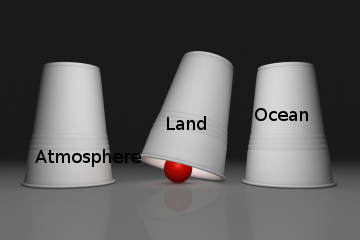Title: Re: How much CO2 is from manmade sources..????
Post by Ajax on Sep 25th, 2013 at 5:33pm
Muso while I respect your scientific background, I don't think you are an expert in climate change science. You may understand more than the average joe blogs but from what I can tell you haven't really worked on climate science as part of team of scientists doing investigations, otherwise you would have said so. The amount of independent scientists that are investigating climate change science and writing papers that contradict the IPCC pseudo climate change science is growing. It wont be long before the MAJORITY of scientists START to say that the IPCC has got it all WRONG. Here is another very precise paper that finds the following, Quote:Global and Planetary Change
Ole Humluma, b, Corresponding author contact information, E-mail the corresponding author,
Kjell Stordahlc,
Jan-Erik Solheimd
a Department of Geosciences, University of Oslo, P.O. Box 1047 Blindern, N-0316 Oslo, Norway
b Department of Geology, University Centre in Svalbard (UNIS), P.O. Box 156, N-9171 Longyearbyen, Svalbard, Norway
c Telenor Norway, Finance, N-1331 Fornebu, Norway
d Department of Physics and Technology, University of Tromsø, N-9037 Tromsø, Norway
12. Conclusions
There exist a clear phase relationship between changes of atmospheric CO2 and the different global temperature records, whether representing sea surface temperature, surface air temperature, or lower troposphere temperature, with changes in the amount of atmospheric CO2 always lagging behind corresponding changes in temperature.
(1) The overall global temperature change sequence of events appears to be from 1) the ocean surface to 2) the land surface to 3) the lower troposphere.
(2) Changes in global atmospheric CO2 are lagging about 11–12 months behind changes in global sea surface temperature.
(3) Changes in global atmospheric CO2 are lagging 9.5–10 months behind changes in global air surface temperature.
(4) Changes in global atmospheric CO2 are lagging about 9 months behind changes in global lower troposphere temperature.
(5) Changes in ocean temperatures appear to explain a substantial part of the observed changes in atmospheric CO2 since January 1980.
(6) CO2 released from anthropogene sources apparently has little influence on the observed changes in atmospheric CO2, and changes in atmospheric CO2 are not tracking changes in human emissions.
(7) On the time scale investigated, the overriding effect of large volcanic eruptions appears to be a reduction of atmospheric CO2, presumably due to the dominance of associated cooling effects from clouds associated with volcanic gases/aerosols and volcanic debris.
(8) Since at least 1980 changes in global temperature, and presumably especially southern ocean temperature, appear to represent a major control on changes in atmospheric CO2.
Read all here
Global and Planetary Change
http://www.sciencedirect.com/science/article/pii/S0921818112001658 |
|
Quote:The phase relation between atmospheric carbon dioxide and global temperature
Abstract
Using data series on atmospheric carbon dioxide and global temperatures we investigate the phase relation (leads/lags) between these for the period January 1980 to December 2011.
Ice cores show atmospheric CO2 variations to lag behind atmospheric temperature changes on a century to millennium scale, but modern temperature is expected to lag changes in atmospheric CO2, as the atmospheric temperature increase since about 1975 generally is assumed to be caused by the modern increase in CO2.
In our analysis we use eight well-known datasets:
1) globally averaged well-mixed marine boundary layer CO2 data,
2) HadCRUT3 surface air temperature data,
3) GISS surface air temperature data,
4) NCDC surface air temperature data,
5) HadSST2 sea surface data,
6) UAH lower troposphere temperature data series,
7) CDIAC data on release of anthropogene CO2, and
8) GWP data on volcanic eruptions. Annual cycles are present in all datasets except 7) and 8), and to remove the influence of these we analyze 12-month averaged data.
We find a high degree of co-variation between all data series except 7) and 8), but with changes in CO2 always lagging changes in temperature.
The maximum positive correlation between CO2 and temperature is found for CO2 lagging 11–12 months in relation to global sea surface temperature, 9.5–10 months to global surface air temperature, and about 9 months to global lower troposphere temperature.
The correlation between changes in ocean temperatures and atmospheric CO2 is high, but do not explain all observed changes. |
|
Quote:Highlights
► Changes in global atmospheric CO2 are lagging 11–12 months behind changes in global sea surface temperature.
► Changes in global atmospheric CO2 are lagging 9.5–10 months behind changes in global air surface temperature.
► Changes in global atmospheric CO2 are lagging about 9 months behind changes in global lower troposphere temperature.
► Changes in ocean temperatures explain a substantial part of the observed changes in atmospheric CO2 since January 1980.
► Changes in atmospheric CO2 are not tracking changes in human emissions. |
|
|
 massbal1.gif (2 KB | 58
)
massbal1.gif (2 KB | 58
) massbal1.gif (2 KB | 58
)
massbal1.gif (2 KB | 58
)

